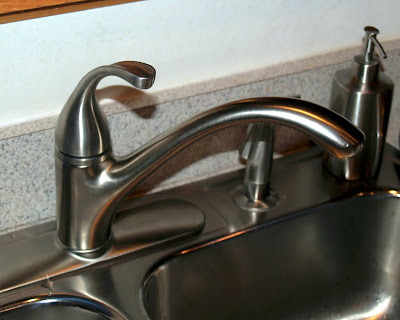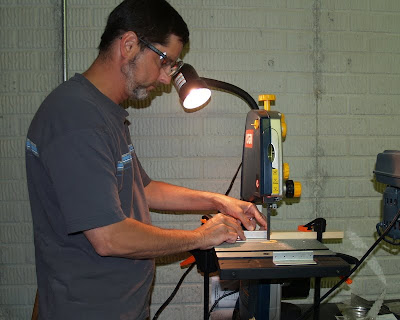Summer is definitely a more difficult season for airplane building.The construction itself is not negatively impacted with any kind of increased difficulty due to the more temperate weather; it is the finding of time to do the work that seems to become more challenging. It doesn't get dark outside until well after 9:00 now and that leaves plenty of daylight wasted if I recuse myself to the basement too early. Over and above that come the time demands of maintaining the lawn and other aspects of the house.
Last night it was the kitchen faucet. It had commenced to leaking (or, at least, was discovered to have begun leaking - those are not the same thing) a few days ago. I originally thought that one of the copper pipes was leaking at a soldered joint and, that being a repair job far outside the boundaries of common sense, called in a plumber. "Nope," said he, " it just needs a new faucet." At which point he proceeded directly into further breaking the faucet by disassembling it and re-assembling it in a manner which somehow binded the handle so that we could turn the water on easily but had to push down mightily on the cap to get it turned off. He wanted $200 to replace it.
Through a misunderstanding on my part, I thought he wanted $325 for the labor alone. As much as I relished the idea of not having to try to replace it myself, I was reluctant to spend that much. My concern was not so much that I wouldn't be able to install a new faucet, rather it was that I wouldn't be able to get the old one off. The attachment nut and bolt are way up there behind the garbage disposal and surrounding cabinetry, the nut was quite visibly corroded, and the whole enchilada was surrounded by wrench-repelling hoses. I was afraid that I'd get as far as making the thing completely inoperable and then get stuck. High & dry, as it were.
I circled around it for a few days, casting askance glances at it like a cheetah getting ready to pounce on a giraffe. The giraffe is not known for its ferocity in a fight, but it's still a big job for a cheetah. Loins require significant girding before committing to that kind of job. 'Tis the way of nature.
And plumbing.
I finally decided that my loins were every bit as girded as they were likely to get and dove under the sink with a flashlight, a wrench, and a firm resolve to quit if it appeared that the resistance to my efforts was going to lead to a stalemate which, in this case, would equate to a defeat if it lead to an unusable water source. While I can't definitively state that my worries were for naught (after all, the liberal two-day soaking of WD-40 might have actually softened up the opposition), the old faucet came off fairly easily.
With the broken parts successfully removed and the new unit set into position, I figured I was most of the way home. "Why," I confidently said to the co-owner, "the only thing that could go wrong now would be for the hoses on the new faucet to be too short."
Think about that for just minute, knowing what you know about how these things tend to work out for me.
So, back to Lowe's for extension hoses. I only needed 6" hoses, but the shortest I could find were 16". No complaints on that, though - it took me long enough to even find those since they were cleverly hidden behind a pile of the wrong type of hose and I was singing Hosanna when I finally found them.
The nice thing about being able to do a lot of the airplane building work in the basement is that I can finish up a job like that, look at the clock, and decide that I still have an hour that I can spend on the airplane. The fuselage came back from the hangar last night (The Jackson Two came for a shop visit and I was able to beg a ride on their big pick-up) but the most immediate work could have been done independently of that.
The next few days will have me attaching the steps that the pilot and passenger/co-pilot will use to climb up on the front of the wing to get into the plane. The RV-12 wing sits further back along the fuselage than the rest of the RV wings do and it turns out to be easier to get into the cockpit from the front rather than behind. As you can imagine, those steps are going to have quite a bit of weight put on them, and that weight is going to be transferred to thin aluminum seat ribs in the fuselage. Those ribs will need to be braced with more substantial aluminum to support that weight.
The braces get cut from a length of thick aluminum angle stock:
If cutting those pieces apart doesn't convince you that you need a band saw, the following step (heh!) will. Two of the braces get trimmed down even further:
I thought it might be difficult to make a long cut like that straight enough, even using the band saw. I adopted an idea suggested by The Jackson Two and clamped a piece of wood to the table of the band saw to slide the aluminum along while cutting:
That worked, to a degree. A lot of degrees, actually. About halfway along the cut, the saw blade started to twist and go off course. I had to turn the aluminum against the twist to try to keep the cut straight. That caused a lot of friction between the side of the blade of the aluminum, which in turn caused the aluminum to get very hot. A lot of degrees. Get it? In any case, I used gloves for the second one after getting pretty toasty fingertips on the first one. You can see that the cuts weren't completely straight:
The aluminum stock isn't corrosion-resistant Alclad like the rest of the parts, so these had to be hit with some primer:
Reading ahead in the plans, I saw that the opening at the top of the steps needs to be filled with the same goopy, messy sealant that will be used to build the fuel tank, so I went ahead and ordered some from Van's. It will hopefully arrive in the next day or two so I can press on with getting the steps attached.








No comments:
Post a Comment